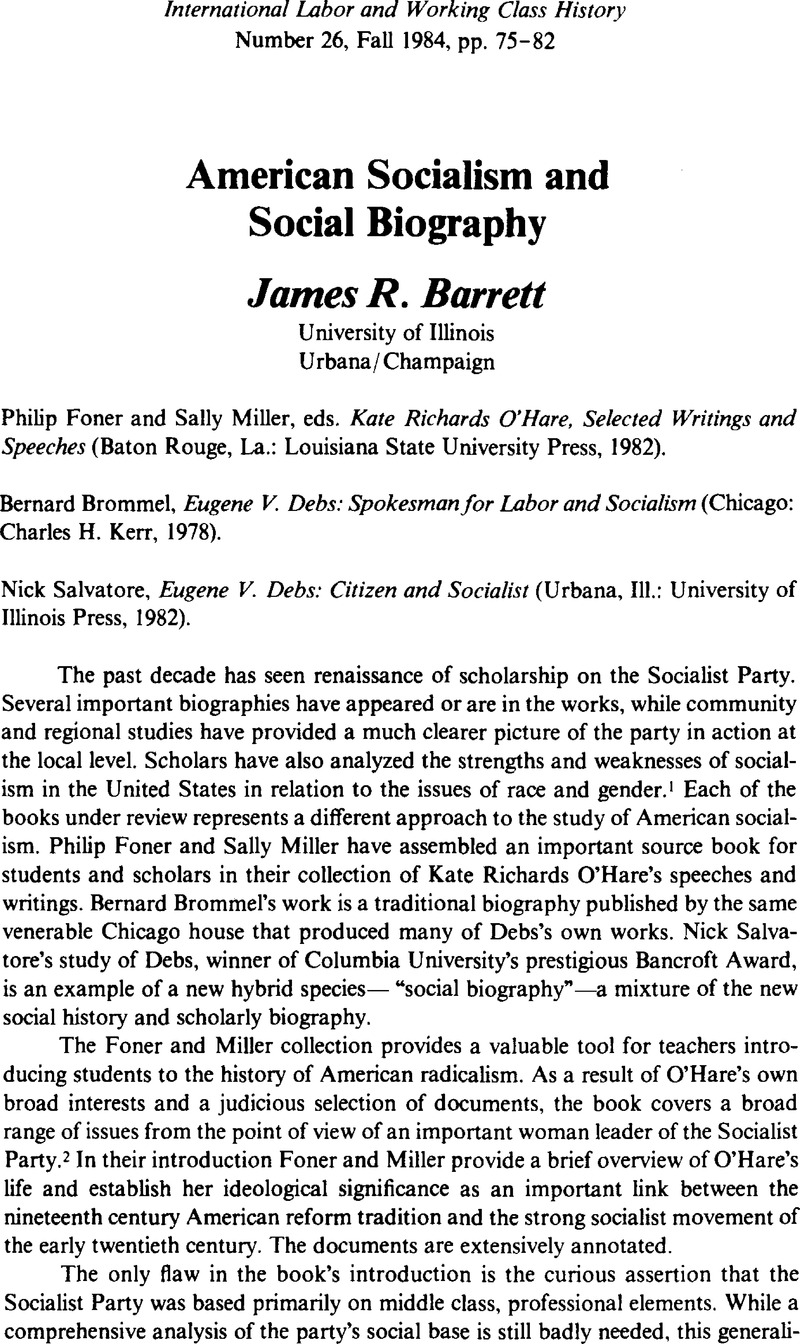Published online by Cambridge University Press: 16 December 2008

1. See, for example, Miller, Sally M., Victor Berger and the Promise of Constructive Socialism, 1910–1920 (Westport, Ct., 1973)Google Scholar; Green, James R., Grass Roots Socialism: Radical Movements in the Southwest (Baton Rouge, 1978)Google Scholar; Foner, Philip, American Socialism and Black Americans: From the Age of Jackson to World War II (Westport, Ct., 1977)Google Scholar; Buhle, Mari Jo, Women and American Socialism, 1870–1920 (Urbana, Ill., 1981).Google Scholar
2. Neil Basen is preparing a full-length biography of O'Hare. For an overview of her socialist career, see Basen, Neil K., “Kate Richards O'Hare: The ‘First Lady’ of American Socialism, 1901–1917,” Labor History 21 (1980), 165–99.CrossRefGoogle Scholar
3. For studies which demonstrate a large working class membership in two very different regions, see Leinenweber, Charles, “The Class and Ethnic Bases of New York City Socialism, 1904–1915,” Labor History 22 (1981), 31–56CrossRefGoogle Scholar and Green, James R., “The ‘Salesman-Soldiers’ of the Appeal ‘Army’: A Profile of Rank and File Socialist Agitators” in Stave, Bruce M., ed. Socialism and the Cities (Port Washington, N.Y., 1975), 13–40.Google Scholar The party canvas is cited in Hillquit, Morris, History of Socialism in the United States (N.Y., 1910), 354–55.Google Scholar On the rapid growth of language federations, see Weinstein, James, The Decline of Socialism in America, 1912–1925 (N.Y., 1969), 182–84.Google Scholar
4. I do not intend to minimize the significance of factional cleavages in the party's decline, but such divisions rose in part from the transformation that had occurred in the membership by the end of World War One. See Weinstein, , The Decline of Socialism in America, Chapters Four and Five.Google Scholar
5. There are notable exceptions, of course—Dubofsky, Melvyn and Tine, Warren Van, John L. Lewis: A Biography (N. Y., 1977)Google Scholar and Seretan, L. Glen, Daniel DeLeon: The Odyssey of an American Marxist (Cambridge, Mass., 1979)CrossRefGoogle Scholar, for example. To see just how rare such exceptions are, however, note the preponderance of community and workshop studies in the following assessments of the “new labor history”: Brody, David, “The Old Labor History and the New: In Search of an American Working Class,” Labor History 20 (1979), 111–26CrossRefGoogle Scholar; Montgomery, David, “To Study the People: The American Working Class,” Labor History 21 (1980), 485–512.CrossRefGoogle Scholar
6. The phrase is Hobsbawn's, E. J., See “From Social History to the History of Society,” Daedalus, 100 (1971), 20–45.Google Scholar
7. See, for example, Dawley, Alan, Class and Community: The Industrial Revolution in Lynn (Cambridge, Mass., 1976)Google Scholar; Fink, Leon, Workingmen's Democracy: The Knights of Labor and Ameri can Politics (Urbana, Illinois, 1983)Google Scholar; Montgomery, David, “Workers' Control of Machine Production in the Nineteenth Century” in the author's Workers' Control in America: Studies in Work, Technology, and Labor Struggles (Cambridge and New York, 1979).Google Scholar For a rare analysis of the fragmentation of this working class republican ideology in the early twentieth century, see Montgomery, David, “Labor and the Republic in Industrial America, 1880–1920,” Le Mouvement Social, 110 (1980), 201–215.CrossRefGoogle Scholar
8. Seratan, L. Glen, “Biography and Antibiography,” Reviews in American History 11 (09 1983), 394–98.CrossRefGoogle Scholar
9. Ginger, Ray, Eugene V. Debs: A Biography (N.Y., 1962), 33.Google Scholar
10. Brody, David, “Labor History in the 1970s: Toward a History of the American Worker” in Kammen, Michael, ed. The Past Before Us, Contemporary Historical Writing in the United States (Ithaca, 1980), 252–69.Google Scholar